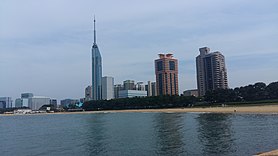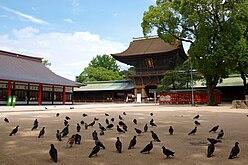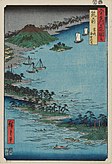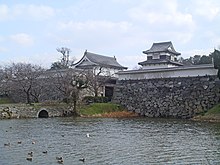Fukuoka
Fukuoka
福岡市 | |
|---|---|
| Fukuoka City | |
From top left: Seaside Momochi within Fukuoka Tower, Tenjin area in Chūō-ku, Fukuoka Castle, Hakozaki Shrine, Hakata Station, Bayside Place Hakata Port, and Fukuoka PayPay Dome | |
 Flag  Seal | |
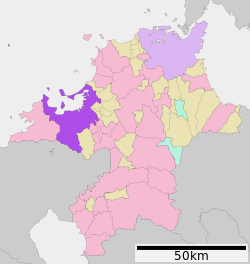 Location of Fukuoka in Fukuoka | |
 Fukuoka Location of Japan | |
| Coordinates: 33°35′N 130°24′E / 33.583°N 130.400°ECoordinates: 33°35′N 130°24′E / 33.583°N 130.400°E | |
| Country | Japan |
| Region | Kyushu |
| Prefecture | Fukuoka Prefecture |
| First official recorded | 57 AD |
| City Settled | April 1, 1889 |
| Government | |
| • Mayor | Sōichirō Takashima (since December 2010) |
| Area | |
| • Designated city | 343.39 km2 (132.58 sq mi) |
| Population (June 1, 2021) | |
| • Designated city | 1,603,543 |
| • Density | 4,700/km2 (12,000/sq mi) |
| • Metro [1] (2015) | 2,565,501 (5th) |
| Time zone | UTC+9 (Japan Standard Time) |
| – Tree | Camphor laurel |
| – Flower | Camellia |
| – Bird | Black-headed gull |
| Website | www |
| Fukuoka | |||||
|---|---|---|---|---|---|
"Fukuoka" in kanji | |||||
| Japanese name | |||||
| Kanji | 福岡 | ||||
| Hiragana | ふくおか | ||||
| Katakana | フクオカ | ||||
| |||||
Fukuoka (福岡市, Fukuoka-shi, pronounced [ɸɯ̥kɯoka̠ꜜɕi]) is the sixth-largest city in Japan, the second-largest port city after Yokohama, and the capital city of Kyushu, Japan.[2] The city is built along the shores of Hakata Bay, and has been a center of international commerce since ancient times. The area has long been considered the gateway to the country, as it is the nearest point among Japan's main islands to the Asian mainland. Although humans occupied the area since the Jomon period, some of the earliest settlers of the Yayoi period arrived in the Fukuoka area. The city rose to prominence during the Yamato period. Because of the cross-cultural exposure, and the relatively great distance from the social and political centers of Kyoto, Osaka, and later, Edo (Tokyo), Fukuoka gained a distinctive local culture and dialect that has persisted to the present.
Fukuoka is the most populous city on the island, followed by Kitakyushu. It is the largest city and metropolitan area west of Keihanshin. The city was designated on April 1, 1972, by government ordinance. Greater Fukuoka, with a population of 2.5 million people (2005 census), is part of the heavily industrialized Fukuoka–Kitakyushu zone.
As of 2015, Fukuoka is Japan's sixth largest city, having passed the population of Kobe.[3] In July 2011, Fukuoka surpassed the population of Kyoto. Since the founding of Kyoto in 794, this marks the first time that a city west of the Kinki region has a larger population than Kyoto.
History[]
Pre-history[]
Exchanges from the continent and the Northern Kyushu area date as far back as Old Stone Age.[4] It has been thought that waves of immigrants arrived in Northern Kyushu from mainland Asia.[5] Several Kofun exist.
Fukuoka was sometimes called the Port of Dazaifu (大宰府), 15 km (9 mi) southeast from Fukuoka. Dazaifu was an administrative capital in 663 A.D., but a historian proposed that a prehistoric capital was in the area.[6] Ancient texts, such as the Kojiki, Kanyen (found in Dazaifu) and archaeology confirm this was a critical place in the founding of Japan. Some scholars[7] claim that it was the first place outsiders and the Imperial Family set foot, but like many early Japan origin theories, it remains contested. Central Fukuoka is sometimes still referred as Hakata which is the name of the central ward.
In 923, the Hakozaki-gū in Fukuoka was transferred from Daibu-gū in Daibu (大分), 16 km (10 mi) northeast from Dazaifu, the origin of Usa Shrine and established as a branch of the Usa Shrine at Fukuoka.[8] In Ooho (大保), 15 km (9 mi) south from Dazaifu, there are remains of a big ward office with a temple, because in ancient East Asia, an emperor must have three great ministries (大宰, 大傳 and 大保). In fact, there is a record in Chinese literature that a king of Japan sent a letter in 478 to ask the Chinese emperor's approval for employing three ministries. In addition, remains of the Korokan (鴻臚館, Government Guest House) were found in Fukuoka underneath a part of the ruins of Fukuoka Castle.

Korokan
Mongol invasions (1274–1281)[]
Kublai Khan of the Mongol Empire turned his attention towards Japan starting in 1268, exerting a new external pressure on Japan with which it had no experience. Kublai Khan first sent an envoy to Japan to make the Shogunate acknowledge Khan's suzerainty.[9] The Kamakura shogunate refused. Mongolia repeatedly sent envoys thereafter, each time urging the Shogunate to accept their proposal, but to no avail.
In 1274, Kublai Khan mounted an invasion of the northern part of Kyushu with a fleet of 900 ships and 33,000 troops, including troops from Goryeo on the Korean Peninsula.[10] This initial invasion was compromised by a combination of incompetence and severe storms. After the invasion attempt of 1274, Japanese samurai built a stone barrier 20 km (12 mi) in length bordering the coast of Hakata Bay in what is now the city of Fukuoka. The wall, 2–3 metres in height and having a base width of 3 metres, was constructed between 1276 and 1277, and was excavated in the 1930s.
Kublai sent another envoy to Japan in 1279. At that time, Hōjō Tokimune of the Hōjō clan (1251–1284) was the Eighth Regent. Not only did he decline the offer, but he beheaded the five Mongolian emissaries after summoning them to Kamakura. Infuriated, Kublai organized another attack on Fukuoka Prefecture in 1281, mobilizing 140,000 soldiers and 4,000 ships. The Japanese defenders, numbering around 40,000, were no match for the Mongols and the invasion force made it as far as Dazaifu, 15 km (9 mi) south of the city of Fukuoka. However, the Japanese were again aided by severe weather, this time by a typhoon that struck a crushing blow to the Mongolian troops, thwarting the invasion.
It was this typhoon that came to be called the Kamikaze (Divine Wind), and was the origin of the term Kamikaze used to indicate suicide attacks by military aviators of the Empire of Japan against Allied naval vessels during World War II.
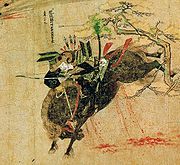
Takezaki Suenaga
Formation of the modern city (1889)[]
Fukuoka was formerly the residence of the powerful daimyō of Chikuzen Province, and played an important part in the medieval history of Japan. The renowned temple of Tokugawa Ieyasu in the district was destroyed by fire during the Boshin War of 1868.
The modern city was formed on April 1, 1889, with the merger of the former cities of Hakata and Fukuoka. Historically, Hakata was the port and merchant district, and was more associated with the area's culture and remains the main commercial area today. On the other hand, the Fukuoka area was home to many samurai, and its name has been used since Kuroda Nagamasa, the first daimyō of Chikuzen Province, named it after his birthplace in Okayama Prefecture[11] and the "old Fukuoka" is the main shopping area, now called Tenjin.
When Hakata and Fukuoka decided to merge, a meeting was held to decide the name for the new city. Hakata was initially chosen, but a group of samurai crashed the meeting and forced those present to choose Fukuoka as the name for the merged city.[citation needed] However, Hakata is still used to refer to the Hakata area of the city and, most famously, to refer to the city's train station, Hakata Station, and dialect, Hakata-ben.

Kuroda Nagamasa
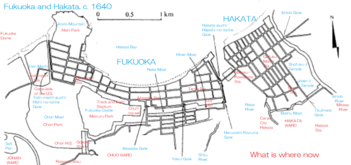
Fukuoka and Hakata, c.1640
Fukuoka Castle
20th century[]
- 1903: Fukuoka Medical College, a campus associated with Kyoto Imperial University, is founded. In 1911, the college is renamed Kyushu Imperial University and established as a separate entity.
- 1910: Fukuoka streetcar service begins. (The service ran until 1979.)
- 1929: Flights commence along the Fukuoka-Osaka-Tokyo route.
- 1945: Fukuoka was firebombed on June 19, with the attack destroying 21.5 percent of the city's urban area.[11]
- 1947: First Fukuoka Marathon.
- 1951: Fukuoka airport opens.[12]
- 1953: Fukuoka Zoo opens.
- 1975: The city absorbed the town of Sawara.
- 1975: Sanyō Shinkansen high-speed railway reaches Hakata station.
- 1981: Subway commences service.
- 1988: Osaka's pro baseball team, the Nankai Hawks, was moved to Fukuoka and renamed the Fukuoka Daiei Hawks (renamed the Fukuoka SoftBank Hawks in 2004).
- 1989: Asian-Pacific Exposition is held.[13]
- 1997: The 30th annual meeting of the Asian Development Bank was held in Fukuoka.

Kyushu University (Former Imperial University)

Fukuoka war damage monument
21st century[]
- 2005: Fukuoka subway Nanakuma Line started operations.
- 2014: Selected as the National Strategic Zone for "global startups & job creation" by the Japanese government.[14]
- 2020: City of Fukuoka was hit by COVID-19 pandemic. As of October 2020, there were 99 related deaths due to COVID-19 surges in Fukuoka prefecture.[15]
- 2021: By August, a new Covid emergency was declared: deaths had risen to 551.[16]
Geography[]

Fukuoka is bordered on three sides by mountains, surrounds Hakata Bay and opens on the north to the Genkai Sea. It is located 1,100 km (684 mi) from Tokyo.
The nearest overseas region is Busan Metropolitan City in Gyeongsang-do, South Korea, and the distance from Busan is about 180 km (112 miles). Fukuoka and Busan are sister cities.
Climate[]
Fukuoka has a humid subtropical climate (Köppen: Cfa), hot and humid summers, and relatively mild winters.[17] The city also sees on average about 1,600 mm (63 in) of precipitation per year, with a stretch of more intense precipitation between the months of June and September.
Along with much of the prefecture, Fukuoka City has a moderate climate with an annual average temperature of 16.3 °C (61 °F), average humidity of 70% and 1,811 annual daylight hours. Roughly 40% of the year is cloudy.
Winter temperatures rarely drop below 0 °C (32 °F) and it rarely snows, though light rain does fall on most days if not as consistently as on the Sea of Japan side of Honshu.[18] Spring is warm and sunnier, with cherry blossoms appearing in late March or early April. The rainy season (tsuyu) lasts for approximately six weeks through June and July, during which time the humidity is very high and temperatures hover between 25 °C (77 °F) and 30 °C (86 °F). Summers are humid and hot, with temperatures peaking around 37 °C (99 °F). Autumn, often considered to be Fukuoka's best season, is mild and dry, though the typhoon season runs between August and September.
| Climate data for Fukuoka (1991−2020 normals, extremes 1890−present) | |||||||||||||
|---|---|---|---|---|---|---|---|---|---|---|---|---|---|
| Month | Jan | Feb | Mar | Apr | May | Jun | Jul | Aug | Sep | Oct | Nov | Dec | Year |
| Record high °C (°F) | 21.5 (70.7) |
24.3 (75.7) |
26.3 (79.3) |
30.1 (86.2) |
32.3 (90.1) |
37.3 (99.1) |
38.3 (100.9) |
38.1 (100.6) |
37.1 (98.8) |
33.3 (91.9) |
28.2 (82.8) |
26.0 (78.8) |
38.3 (100.9) |
| Average high °C (°F) | 10.2 (50.4) |
11.6 (52.9) |
15.0 (59.0) |
19.9 (67.8) |
24.4 (75.9) |
27.2 (81.0) |
31.2 (88.2) |
32.5 (90.5) |
28.6 (83.5) |
23.7 (74.7) |
18.2 (64.8) |
12.6 (54.7) |
21.3 (70.3) |
| Daily mean °C (°F) | 6.9 (44.4) |
7.8 (46.0) |
10.8 (51.4) |
15.4 (59.7) |
19.9 (67.8) |
23.3 (73.9) |
27.4 (81.3) |
28.4 (83.1) |
24.7 (76.5) |
19.6 (67.3) |
14.2 (57.6) |
9.1 (48.4) |
17.3 (63.1) |
| Average low °C (°F) | 3.9 (39.0) |
4.4 (39.9) |
7.2 (45.0) |
11.5 (52.7) |
16.1 (61.0) |
20.3 (68.5) |
24.6 (76.3) |
25.4 (77.7) |
21.6 (70.9) |
16.0 (60.8) |
10.6 (51.1) |
5.8 (42.4) |
14.0 (57.2) |
| Record low °C (°F) | −6.0 (21.2) |
−8.2 (17.2) |
−4.7 (23.5) |
−1.4 (29.5) |
1.4 (34.5) |
4.3 (39.7) |
13.8 (56.8) |
15.4 (59.7) |
7.9 (46.2) |
0.4 (32.7) |
−2.1 (28.2) |
−5.4 (22.3) |
−8.2 (17.2) |
| Average precipitation mm (inches) | 74.4 (2.93) |
69.8 (2.75) |
103.7 (4.08) |
118.2 (4.65) |
133.7 (5.26) |
249.6 (9.83) |
299.1 (11.78) |
210.0 (8.27) |
175.1 (6.89) |
94.5 (3.72) |
91.4 (3.60) |
67.5 (2.66) |
1,686.9 (66.41) |
| Average snowfall cm (inches) | 1 (0.4) |
1 (0.4) |
0 (0) |
0 (0) |
0 (0) |
0 (0) |
0 (0) |
0 (0) |
0 (0) |
0 (0) |
0 (0) |
0 (0) |
2 (0.8) |
| Average precipitation days (≥ 0.5 mm) | 11.0 | 10.7 | 11.4 | 10.8 | 9.8 | 12.7 | 12.4 | 11.2 | 11.0 | 7.9 | 9.9 | 10.2 | 128.9 |
| Average relative humidity (%) | 63 | 62 | 63 | 64 | 67 | 75 | 75 | 72 | 73 | 68 | 66 | 63 | 68 |
| Mean monthly sunshine hours | 104.1 | 123.5 | 161.2 | 188.1 | 204.1 | 145.2 | 172.2 | 200.9 | 164.7 | 175.9 | 137.3 | 112.2 | 1,889.4 |
| Average ultraviolet index | 3 | 4 | 6 | 8 | 9 | 10 | 11 | 10 | 8 | 6 | 4 | 3 | 7 |
| Source: Japan Meteorological Agency[19] and Weather Atlas[20] | |||||||||||||
Disaster[]
Earthquakes[]
Fukuoka is not as seismically active as many other parts of Japan, but does experience occasional earthquakes. The most powerful recent earthquake registered a lower 6 of maximum 7 of the Japanese intensity scale and hit at 10:53 am local time on March 20, 2005, killing one person and injuring more than 400.[21] The epicentre of the earthquake was in the Genkai Sea along a yet-undiscovered extension of the Kego fault that runs through the centre of Fukuoka. Genkai island, a part of Nishi-ku, was the most severely damaged by the earthquake and almost all island residents were forced to evacuate. Aftershocks continued intermittently throughout the following weeks as construction crews worked to rebuild damaged buildings throughout the city. Traditional Japanese houses, particularly in the areas of Daimyo and Imaizumi, were the most heavily damaged and many were marked for demolition, along with several apartment buildings. Insurance payments for damages were estimated at approximately 15.8 billion yen.[22]
A similar quake, with an intensity of 5+, also occurred one month later on April 20, 2005.
Fukuoka's major Kego fault runs northwest to southeast, roughly parallel to Nishitetsu's Ōmuta train line, and was previously thought to be 22 km (14 mi) long. It is estimated to produce earthquakes as strong as magnitude 7 at the focus approximately once every 15,000 years. If the focus were located at a depth of 10 km (6 mi), this would translate to an earthquake of a lower-6 magnitude (similar to the March 20, 2005 earthquake) in downtown Fukuoka if it were the epicenter. The probability of an earthquake along the known length of the Kego fault occurring within 30 years was estimated at 0.4% prior to the March 20, 2005 earthquake, but this probability has been revised upwards since. Including the new extension out into the Genkai Sea, the Kego fault is now thought to be 40 km (25 mi) long.
Following reports that the city has only prepared for earthquakes up to a magnitude of 6.5, several strong aftershocks renewed fears that the quakes might cause the portion of the Kego fault that lies under the city to become active again, leading to an earthquake as big as, or bigger than, the March 20 quake.[citation needed]
Wards[]
Fukuoka has 7 wards (ku).
| Wards of Fukuoka | |||||||
|---|---|---|---|---|---|---|---|
| Place Name | Map of Fukuoka | ||||||
| Rōmaji | Kanji | Color | Population | Land area in km2 | Pop. density
per km2 |
||
| 1 | Higashi-ku | 東区 | 291 749 | 66.68 | 4 375.36 | 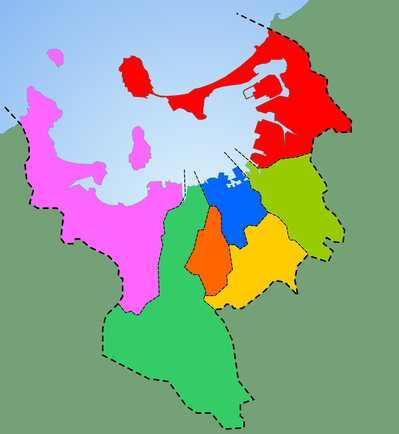 | |
| 2 | Hakata-ku | 博多区 | 212 108 | 31.47 | 6 740.01 | ||
| 3 | Chūō-ku (administrative center) |
中央区 | 176 739 | 15.16 | 11,658.24 | ||
| 4 | Minami-ku | 南区 | 248 901 | 30.98 | 8 034.25 | ||
| 5 | Jōnan-ku | 城南区 | 128 883 | 16.02 | 8 045.13 | ||
| 6 | Sawara-ku | 早良区 | 211 889 | 95.88 | 2 209.42 | ||
| 7 | Nishi-ku | 西区 | 190 288 | 83.81 | 2 270.47 | ||
Cityscape[]
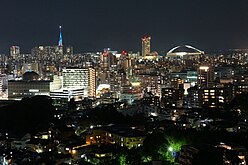
Skyline of Fukuoka
Tenjin area
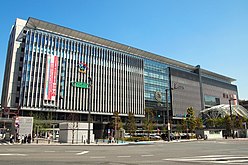
JR Kyushu's Hakata Station
Tenjin Underground City
Demographics[]
| Year | Pop. | ±% |
|---|---|---|
| 1920 | 239,956 | — |
| 1925 | 274,414 | +14.4% |
| 1930 | 321,276 | +17.1% |
| 1935 | 372,500 | +15.9% |
| 1940 | 398,478 | +7.0% |
| 1945 | 416,332 | +4.5% |
| 1950 | 487,885 | +17.2% |
| 1955 | 591,868 | +21.3% |
| 1960 | 632,365 | +6.8% |
| 1965 | 769,176 | +21.6% |
| 1970 | 871,717 | +13.3% |
| 1975 | 1,002,201 | +15.0% |
| 1980 | 1,088,588 | +8.6% |
| 1985 | 1,160,440 | +6.6% |
| 1990 | 1,237,062 | +6.6% |
| 1995 | 1,284,795 | +3.9% |
| 2000 | 1,341,470 | +4.4% |
| 2005 | 1,401,279 | +4.5% |
| 2010 | 1,463,826 | +4.5% |
| 2015 | 1,538,681 | +5.1% |
| 2020 | 1,603,043 | +4.2% |
As of November 2018, the city had an estimated population of 1,581,527 and a population density of 4,515.64 inhabitants per square kilometre (11,695.5/sq mi).[23] The total area is 343.39 square kilometres (132.58 sq mi). Fukuoka is Japan's youngest major city and has Japan's fastest growing population.[24] Between December 2012 and December 2017, the proportion of foreign-born residents increased faster than any other major city in Japan, including Tokyo.[25]
There were 171 homeless residents counted in 2018's annual survey, down from a high of 969 in 2009.[26]
Economy[]

Fukuoka is the economic center of the Kyushu region, with an economy largely focused on the service sector. It is also the largest startup city in Japan, and is the only economic zone for startups.[27] They have various services for startups like startup visa, tax reduction, and free business consultations. Fukuoka has the highest business-opening rate in Japan.[28] Large companies headquartered in the city include Iwataya and Kyushu Electric Power. Fukuoka is also the home of many small firms playing a supportive role in the logistics, IT, and high-tech manufacturing sectors. Most of the region's heavy manufacturing takes place in the nearby city of Kitakyushu.
The GDP in Greater Fukuoka, Fukuoka Metropolitan Employment Area, was US$101.6 billion in 2010.[29][30] Fukuoka is the primary economic center of the Fukuoka-Kitakyushu metropolitan area, which is the 4th largest economy in Japan. As of 2014, the area's PPP-adjusted GDP is estimated to be larger than those of metropolitan areas such as Melbourne, Kuala Lumpur, Lima, Vienna, Barcelona and Rome.[31]
Several regional broadcasters are based in the city, including Fukuoka Broadcasting Corporation, Kyushu Asahi Broadcasting, Love FM, RKB Mainichi Broadcasting, and Television Nishinippon Corporation.
The port of Hakata and Fukuoka Airport also make the city a key regional transportation hub. Fukuoka houses the headquarters of Kyushu Railway Company (JR Kyushu) and Nishi-Nippon Railroad. Air Next, a subsidiary of All Nippon Airways, is headquartered in Hakata-ku;[32] prior to its dissolution, Harlequin Air was also headquartered in Hakata-ku.[33]
Fukuoka has its own stock exchange, founded in 1949. It is one of six in Japan.[34]
Fukuoka is one of the more affordable cities in Japan.[35]
Culture[]

Fukuoka was selected as one of Newsweek's 10 "Most Dynamic Cities" in its July 2006 issue.[36] It was chosen for its central Asian location, increasing tourism and trade, and a large increase in volume at its sea and airport. Fukuoka has a diverse culture and a wide range of cultural attractions.
In its July/August 2008 issue, Monocle selected Fukuoka as number 17 of the "Top 25 liveable cities".[37] It was chosen for excellent shopping, outstanding food, good transport links, good museums, "a feeling of openness in its sea air", green spaces and because it is friendly, safe, clean and close to the rest of East Asia.[38] The same survey in 2018 ranked Fukuoka at number 22.[39]
ACROS (Asian Cross Road Over the Sea) is a cultural center located at the Tenjin Central Park. Part of it is the Fukuoka Symphony Hall and it hosts several other cultural events in a green building.
The Fukuoka Asian Culture Prize was established to honor the outstanding work of individuals or organizations in Asia.
Tourism[]
Fukuoka hosts more than 2 million foreign visitors annually, with the majority coming from neighboring South Korea, Taiwan and China.[40] From the early 2010s Hakata became the beneficiary of significant growth in cruise ship tourism; particularly with visitors from China. After expansion and redevelopment of the Hakata Port international passenger ship terminal, the number of cruise ship port calls in 2016 was expected to exceed 400.[41]
Nearly ten thousand international students attend universities in or near the Fukuoka prefecture each year.[42] Nearly 200 international conferences are held each year in Fukuoka.[43]
Attractions[]

Fukuoka Castle, located adjacent to Ohori Park in Maizuru Park, features the remaining stone walls and ramparts[44] left after a devastating fire during the upheaval of the Meiji Restoration. It has now been preserved along with some reconstructed prefabricate concrete towers constructed during the 1950s and 1960s, when there was a trend across Japan to rebuild damaged castles as tourist attractions. Ōhori Park is also the location of one of Fukuoka City's major art galleries.
There are many temples with long histories including Tōchō-ji, Hakozaki Shrine, Kashii shrine, and Jōten-ji. The Buddhist Nanzoin temple is located in Sasaguri, just east of Fukuoka. It is claimed to be the largest statue of a reclining Buddha in the world.
Sky Dream Fukuoka, in Fukuoka's western ward, was a Ferris wheel with a height of 120 meters and was closed in September 2009. The surrounding shopping center, Marinoa City Fukuoka, still attracts millions of visitors each year. Other shopping centers that attract tourists include Canal City, JR Hakata City, and Hakata Riverain.[45]
The Marine Park Uminonakamichi is located on a narrow cape on the northern side of the Bay of Hakata. The park has an amusement park, petting zoo, gardens, beaches, a hotel, and a large marine aquarium which opened in 1989.[46]
For tourists from other parts of Japan, local foods such as mentaiko, Hakata (Tonkotsu) ramen, and motsunabe are associated with Fukuoka. Yatai (street stalls) serving ramen can be found in Tenjin and Nakasu most evenings.
Fukuoka Tower is near the beach in Seaside Momochi, a development built for the 1989 Asia-Pacific Exhibition. The older symbol of the city, Hakata Port Tower is next to the international ferry terminal and is free to enter.
Itoshima, to the west of Fukuoka city, has recently become a very popular tourist destination. There are many beaches along the coast, notably Futamigaura beach, where there is a famous Shinto shrine in the ocean, and Keya beach, which hosts the annual Sunset Live festival every September. Inland, there is the Shingon Buddhist temple called Raizan Sennyoji, where there are many Buddhist statues and stunning autumn foliage.[47]
Museums[]

- Fukuoka Art Museum – In Ohori Park; contains a wide selection of contemporary and other art from around the world, including works by Mark Rothko, Roy Lichtenstein, and Salvador Dalí.
- Fukuoka Asian Art Museum – contains art from various countries of Asia.
- Fukuoka City Museum – displays a broad range of items from the region's history, including a spectacular gold seal.
- Fukuoka Oriental Ceramics Museum
- Fukuoka Prefectural Museum of Art
- Genko Historical Museum (元寇史料館, Museum of the Mongol Invasion) – In Higashi Koen (Eastern Park); displays Japanese and Mongolian arms and armor from the 13th century as well as paintings on historical subjects. Open on weekends.
- Hakata Machiya Folk Museum – Dedicated to displaying the traditional ways of life, speech, and culture of the Fukuoka region.
- Kyushu National Museum in nearby Dazaifu.[48]
Festivals[]

Fukuoka is home to many festivals (matsuri) that are held throughout the year. Of these, the most famous are Hakata Dontaku and Hakata Gion Yamakasa.
Yamakasa[]
Yamakasa (山笠), held for two weeks each July,[49] is Fukuoka's oldest festival with a history of over 700 years. The festival dates back to 1241 when a priest called Shioichu Kokushi saved Hakata from a terrible plague by being carried around the city on a movable shrine and throwing water.[50][51] Teams of men (no women, except small girls, are allowed), representing different districts in the city, commemorate the priest's route by racing against the clock around a set course carrying on their shoulders floats weighing several thousand pounds. Participants all wear shimekomi (called fundoshi in other parts of Japan), which are traditional loincloths.
Each day of the two-week festival is marked by special events and practice runs, culminating in the official race that takes place the last morning before dawn. Tens of thousands line the streets to cheer on the teams. During the festival, men can be seen walking around many parts of Fukuoka in long happi coats bearing the distinctive mark of their team affiliation and traditional geta sandals. The costumes are worn with pride and are considered appropriate wear for even formal occasions, such as weddings and cocktail parties, during the festival.

The uniform used during the ceremonies and preparation.

The uniform used during the competition.
Hakata Dontaku[]
Hakata Dontaku (博多どんたく) is held in Fukuoka City on May 3 and 4. Boasting over 800 years of history, Dontaku is attended by more than 2 million people, making it the festival with the highest attendance during Japan's Golden Week holidays. During the festival, stages are erected throughout downtown for traditional performances and a parade of floats is held. The full name is Hakata Dontaku Minato Matsuri.[52]
The festival was stopped for seven years during the Meiji era. Since it was restarted in the 12th year of the Meiji era it has been known as Hakata Dontaku.
Music[]
Notable musical names in J-pop include Ayumi Hamasaki (allegedly Japan's richest woman), singer-songwriter Ringo Shiina, hugely popular singer-songwriter duo Chage & Aska, singer-songwriter Eri Nobuchika, Misia, Masamune Kusan] and Yui. During the 1970s, local musicians prided themselves on their origins and dubbed their sound, Mentai Rock.
Morning Musume 6th generation member Reina Tanaka was also born here in 1989 along with 9th generation member Erina Ikuta in 1997.
Dominican songwriter and singer Juan Luis Guerra pays homage to the city in his bachata song Bachata en Fukuoka (2010).
HKT 48 have their own Theater at Nishitetsu Hall.
Transport[]


Fukuoka is served by Fukuoka Airport, the San'yō Shinkansen and the Kyushu Shinkansen high-speed rail line and other JR Kyushu trains at Hakata Station and by ferry. JR Kyushu and a Korean company operate hydrofoil ferries (named Beetle and Kobee) between Hakata and Busan, South Korea. The city has three subway lines: the Kūkō Line, the Hakozaki Line, and the newest one, Subway Nanakuma Line, opened on February 2, 2005. A private railway line, run by Nishitetsu is also heavily used and connects the downtown area of Tenjin to the city of Ōmuta.
Sports[]

Fukuoka is the home of the Fukuoka SoftBank Hawks, one of Japan's top professional baseball teams. Threatened with bankruptcy and forced by its creditors to restructure, former owner Daiei sold the Hawks to Softbank Capital in 2004.
Fukuoka is home to a professional football team, Avispa Fukuoka.
Annual sporting events include:
- The All Japan Judo Category Championships are held in early April.
- The Kyushu ekiden, beginning in Nagasaki and ending in Fukuoka, the world's longest relay race, held in October. (Defunct)
- The November tournament of professional Sumo is held at the Fukuoka Kokusai Center.
Fukuoka has hosted the following sporting events:
- Fukuoka Marathon from 1947 through 2021.
- 1983 Asian Volleyball Championship for Women
- 1995 Summer Universiade
- 1997 Pan Pacific Swimming Championships
- 1998 Women's Volleyball World Championship
- 1999 Asian Basketball Championship
- 2001 World Aquatics Championships.
- 2006 IAAF World Cross Country Championships.
- Fukuoka International Women's Judo Championships from 1983 to 2006.
- 2013-14 Grand Prix of Figure Skating Final
Sports teams and facilities[]
| Club | Sports | League | Venue | Established |
|---|---|---|---|---|
| Kyuden Voltex | Rugby | Top League | Level-5 Stadium | 1951 |
| Coca-Cola Red Sparks | Rugby | Top League | Sawayaka Sports Park | 1966 |
| Fukuoka SoftBank Hawks | Baseball | Pacific League | Fukuoka PayPay Dome | 1989 (year of relocation from Ōsaka as Daiei Hawks, changed to current name from 2005) |
| Avispa Fukuoka | Association football | J. League | Level-5 Stadium | 1995 (year of relocation from Fujieda, Shizuoka as Fukuoka Blux, changed to current name from 1996) |
| Fukuoka J-Anclas | Association football | Nadeshiko League | Level-5 Stadium | 1986 (as Fukuoka Jogakuin High School football club, changed to a senior club team and participated Nadeshiko League Div. 2 from 2006) |
| Rizing Zephyr Fukuoka | Basketball | B.League | Accion Fukuoka | 2007 |
Education[]
Fukuoka City operates all public elementary and junior high schools, while the prefecture operates the high schools.
- National universities
- Kyushu University (九州大学, Kyushu Daigaku)
- Kyushu Institute of Design (九州芸術工科大学, Kyushu Geijutsu Kōka Daigaku) – merged with Kyushu University in October 2003
- Prefectural university
- Fukuoka Women's University (福岡女子大学, Fukuoka Joshi Daigaku)
- Private universities
- Daiichi University, College of Pharmaceutical Sciences (第一薬科大学, Daiichi Yakka Daigaku)
- Fukuoka Institute of Technology (福岡工業大学, Fukuoka Kōgyō Daigaku)
- Fukuoka Jo Gakuin University (福岡女学院大学, Fukuoka Jogakuin Daigaku)
- Fukuoka University (福岡大学, Fukuoka Daigaku)
- Kyushu Sangyo University (九州産業大学, Kyushu Sangyō Daigaku)
- Nakamura Gakuen University (中村学園大学, Nakamura Gakuen Daigaku)
- Seinan Gakuin University (西南学院大学, Seinan Gakuin Daigaku)
- Colleges
- Fukuoka College of Health Sciences (福岡医療短期大学, Fukuoka Iryō Tanki Daigaku)
- Fukuoka Institute of Technology, Junior college (福岡工業大学短期大学部|Fukuoka Kōgyō Daigaku Tanki Daigakubu)
- Junshin Junior College (純真短期大学, Junshin Tanki Daigaku)
- Koran Women's Junior College (香蘭女子短期大学, Kōran Joshi Tanki Daigaku)
- Kyushu Zokei Art College (九州造形短期大学, Kyushu Zōkei Tanki Daigaku)
- Nakamura Gakuen Junior College (中村学園大学短期大学部, Nakamura Gakuen Daigaku Tanki Daigakubu)
- Nishinihon Junior College (西日本短期大学, Nishi Nihon Tanki Daigaku)
- Seika Women's Junior College (精華女子短期大学, Seika Joshi Tanki Daigaku)
- Catholic schools
International relations[]
Fukuoka has ten sister cities.[53]
- Atlanta, United States (since February 2005)
- Auckland, New Zealand (since June 1986)
- Bordeaux, France (since November 1982)[54][55]
- Busan, South Korea (since February 2007)
- Delhi, India (since November 2007, friendship city)[56]
- Guangzhou, China (since February 1979)[57]
- Ipoh, Malaysia (since March 1989)
- Oakland, United States (since October 1962)
- Naples, Italy (since October 1983)
- Qingdao, China (since February 2003)
- Yangon, Myanmar (since December 2016)
The city established the Asian Pacific City Summit in 1994. It consists of 26 Asia-Pacific cities. The Asian Pacific Children's Convention was established in Fukuoka in 1988.[58]
Notable people[]
- Jirō Akagawa (novelist)
- Aska (singer) (Chage and Aska)
- Sonny Chiba (actor, singer, film producer, film director, and martial artist)
- Kaibara Ekken (Neo-Confucianist philosopher)
- Noriko Fukuda (TV announcer)
- Kenji Hamada (voice actor)
- Ayumi Hamasaki (J-pop singer)
- Angela Harry (model and actress)
- Riko Higashio (professional golfer)
- Kiyoshi Hikawa (enka singer)
- Kōki Hirota (politician: 32nd Prime Minister of Japan)
- HKT48 (idol group)
- Yōsuke Ideguchi (Footballer for Leeds United)
- Elaiza Ikeda (model and actress)
- Erina Ikuta (J-pop singer and member of Morning Musume)
- Tomo Inouye (medical doctor)
- Ryo Ishibashi (actor, musician)
- Sui Ishida (manga artist)
- Gakuryū Ishii (film director)
- Kanikapila (rock band)
- Ai Kawashima (singer-songwriter)
- Yoshinori Kobayashi (manga artist)
- Masamune Kusano (vocalist of Spitz)
- Yumeno Kyūsaku (novelist)
- Misia (J-pop singer)
- Kento Miyahara (professional wrestler)
- Ryutaro Nakahara (DJ, musician, composer, arranger)
- Kenzo Nakamura (Judo athlete)
- Katsuhiko Nakajima (professional wrestler)
- Ai Nonaka (voice actor)
- Yukari Oshima (actress)
- Victoria Principal (American actress)
- Noriko Sakai (singer and actress)
- Nao Sakuma (principal dancer with Birmingham Royal Ballet)
- Kensuke Sasaki (professional wrestler)
- Sayuri (singer-songwriter)
- Kōji Seto (actor)
- Ringo Shiina (J-pop singer born in Saitama Prefecture and raised in Fukuoka)
- Polkadot Stingray (rock band)
- Keita Tachibana (J-pop singer and member of W-inds)
- Takehiro Tomiyasu (footballer for Arsenal F.C.)
- Akitomo Takeno (basketball player)
- Dan Takuma (businessman)
- Tamori (TV presenter)
- Kane Tanaka (oldest verified Japanese person ever)
- Reina Tanaka (J-pop singer and a member of Morning Musume and Lovendor)
- Ryoko Tani (judo athlete)
- Rintaro Tokunaga (basketball player)
- Misa Uehara (1937–2003), actress
- Ren Kawashiri (J-pop singer/dancer, member of JO1)
- Ryutaro Umeno (baseball player for the Hanshin Tigers)
- Masaaki Yuasa (director)
- Yui (singer)
- Takumi Iroha (Japanese professional wrestler)
- Sosuke Ikematsu (movie actor, television actor, and theatre actor)
See also[]
- 2006 Fukuoka mayoral election
- List of Places of Scenic Beauty of Japan (Fukuoka)
- List of Historic Sites of Japan (Fukuoka)
References[]
- ^ "UEA Code Tables". Center for Spatial Information Science, University of Tokyo. Retrieved January 26, 2019.
- ^ Saibi, Hakim (2018). "Recent Earthquakes and Volcanic Activities in Kyushu Island, Japan". Integrating Disaster Science and Management. Elsevier. pp. 53–67. doi:10.1016/b978-0-12-812056-9.00004-x.
Fukuoka city, capital city of Kyushu Island, southwest of Japan (Fig. 4.2), was struck by a strong earthquake on March 20, 2005 (MJMA7.0).
- ^ 福岡市 平成27年国勢調査結果速報(本市独自集計). city.fukuoka.lg.jp. Archived from the original on August 15, 2016. Retrieved July 25, 2016.
- ^ "Researchers uncover deeper Japan-Korea history on weapons, letters". AJW by The Asahi Shimbun. Archived from the original on October 29, 2013.
- ^ "Austronesia".
- ^ Takehiko Furuta (1993). 失われた九州王朝 [A lost Kyushu dynasty]. Asahi Publishing.
- ^ The Truth of Descent from Heaven. Yukio Yokota. Retrieved March 19, 2008.
- ^ Fukuoka/Hakata Tourist Information website: Hakozaki Shrine
- ^ "MONGOL INVASIONS OF JAPAN".
- ^ "Blown Away: The Mongol Invasions of Japan".
- ^ a b "Archived copy". Archived from the original on April 8, 2017. Retrieved March 26, 2016.CS1 maint: archived copy as title (link)
- ^ "Archived copy". Archived from the original on December 22, 2017. Retrieved April 1, 2016.CS1 maint: archived copy as title (link)
- ^ "History".
- ^ "Council on National Strategic Special Zones (The Prime Minister in Action) | Prime Minister of Japan and His Cabinet". Retrieved July 26, 2016.
- ^ Nippon.com
- ^ Our World in Data
- ^ "Climate – Fukuoka".
- ^ 気象庁 | 平年値(年・月ごとの値). Japan Meteorological Agency. Retrieved June 21, 2012.
- ^ 気象庁 / 平年値(年・月ごとの値). Japan Meteorological Agency.
- ^ d.o.o, Yu Media Group. "Fukuoka, Japan – Detailed climate information and monthly weather forecast". Weather Atlas. Retrieved July 9, 2019.
- ^ "Biggest Earthquakes Near Fukuoka, Japan".
- ^ 地震保険について. Nongovernmental crisis Management & Regeneration Organization (NPO). Archived from the original on January 6, 2009. Retrieved November 9, 2009.".
- ^ 福岡市 福岡市推計人口(最新). city.fukuoka.lg.jp. Retrieved November 19, 2018.
- ^ "増えているのは,選ばれているから。- 人口増加数・増加率、若者(10代・20代)の割合 -". Fukuoka Facts. May 23, 2017. Retrieved November 19, 2018.
- ^ "外国人からの人気も上昇中-在留外国人の伸び率-". Fukuoka Facts. July 31, 2018. Retrieved November 19, 2018.
- ^ "ホームレス自立支援実施計画(第4次)案" (PDF). Fukuoka City Data. Retrieved January 26, 2019.
- ^ 国家戦略特区「福岡市 グローバル創業・雇用創出特区」 (PDF). 国家戦略特区「福岡市 グローバル創業・雇用創出特区」. Fukuoka city government. June 2015. Retrieved July 25, 2016.
- ^ 福岡特区通信. f-tokku.city.fukuoka.lg.jp (in Japanese). Archived from the original on January 23, 2018. Retrieved July 25, 2016.
- ^ Yoshitsugu Kanemoto. "Metropolitan Employment Area (MEA) Data". Center for Spatial Information Science, The University of Tokyo.
- ^ Conversion rates – Exchange rates. OECD Data.
- ^ "Global Metro Monitor". January 22, 2015. Retrieved January 26, 2019.
- ^ 会社概要. Air Next. Archived from the original on December 7, 2004. Retrieved May 20, 2009.
- ^ 会社概要. Harlequin Air. Archived from the original on October 27, 2004. Retrieved May 20, 2009.
- ^ "FSE.org.jp". Fukuoka Stock Exchange. Retrieved April 17, 2011.
- ^ "numbeo.com". Retrieved January 3, 2020.
- ^ Newsweek Print Article. Retrieved November 15, 2008
- ^ Copenhagen named world's best city for quality of life by Monocle magazine Nick Allen, The Daily Telegraph, June 9, 2008
- ^ Monocle, July/August 2008, issue 15, volume 02, page 26
- ^ Monocle Quality of Life survey 2018
- ^ "福岡県のインバウンド需要". Honichi Inbound. 2016. Retrieved November 23, 2018.
- ^ "Cruise ships with Chinese tourists pour into Japan". Japan Today. Kyodo. March 12, 2016. Archived from the original on March 12, 2016.
- ^ http://www.kokusaihiroba.or.jp/english/city/data.html Archived April 9, 2018, at the Wayback Machine Trend in the Number of Foreign Residents Registered in Fukuoka Prefecture (as of end of December 2009)
- ^ 2012 年の 「日本の国際会議 開催件数」 を発表 (PDF). jnto.go.jp. December 18, 2013.
- ^ ], Kyushu Tourism Promotion Organization [ Japan. "FUKUOKA CASTLE RUINS|SIGHTSEEING SPOTS|Kyushu Tourism Information [ Japan ]". Kyushu Tourism Information [ Japan ].CS1 maint: numeric names: authors list (link)
- ^ "福岡市観光統計" (PDF). Fukuoka City Data. March 2, 2017. Retrieved November 23, 2018.
- ^ "Archived copy". Archived from the original on March 19, 2016. Retrieved March 26, 2016.CS1 maint: archived copy as title (link)
- ^ 雷山千如寺 大悲王院 (公式サイト). sennyoji.or.jp.
- ^ "Easy Day Trips From Fukuoka; A North Kyushu Itinerary".
- ^ Hakata Gion Yamakasa Festival Archived February 18, 2011, at the Wayback Machine. Japan National Tourist Organization. Retrieved March 19, 2008.
- ^ The Yamakasa. Cogito Kyushu Networks. Retrieved March 19, 2008.
- ^ Hakata Gion Yamakasa. WebJapan. Retrieved March 19, 2008.
- ^ Hakata Dontaku Minato Matsuri Archived February 6, 2007, at the Wayback Machine. (in Japanese) Fukuoka Chamber of Commerce and Industry. Retrieved March 19, 2008.
- ^ 姉妹都市交流 [Sister City Relations] (in Japanese). Fukuoka City. Archived from the original on March 24, 2012. Retrieved April 7, 2012.
- ^ "Bordeaux – Rayonnement européen et mondial". Mairie de Bordeaux (in French). Archived from the original on February 7, 2013. Retrieved July 29, 2013.
- ^ "Bordeaux-Atlas français de la coopération décentralisée et des autres actions extérieures". Délégation pour l'Action Extérieure des Collectivités Territoriales (Ministère des Affaires étrangères) (in French). Archived from the original on February 7, 2013. Retrieved July 29, 2013.
- ^ "SISTER-CITY AGREEMENTS/ MEMORANDUM". Department of Urban Development, Government of Delhi. Archived from the original on June 1, 2016. Retrieved February 28, 2017.
- ^ "Guangzhou Sister Cities[via WaybackMachine.com]". Guangzhou Foreign Affairs Office. Archived from the original on October 24, 2012. Retrieved July 21, 2013.
- ^ "Asian Pacific Children's Convention". Japan-America Society of Hawaii. Archived from the original on February 28, 2009.
External links[]
| Wikimedia Commons has media related to Fukuoka, Fukuoka. |
| Wikivoyage has a travel guide for Fukuoka. |
| Wikisource has the text of the 1911 Encyclopædia Britannica article "Fukuoka". |
- Fukuoka
- Cities in Fukuoka Prefecture
- Port settlements in Japan
- Populated coastal places in Japan
- Cities designated by government ordinance of Japan
